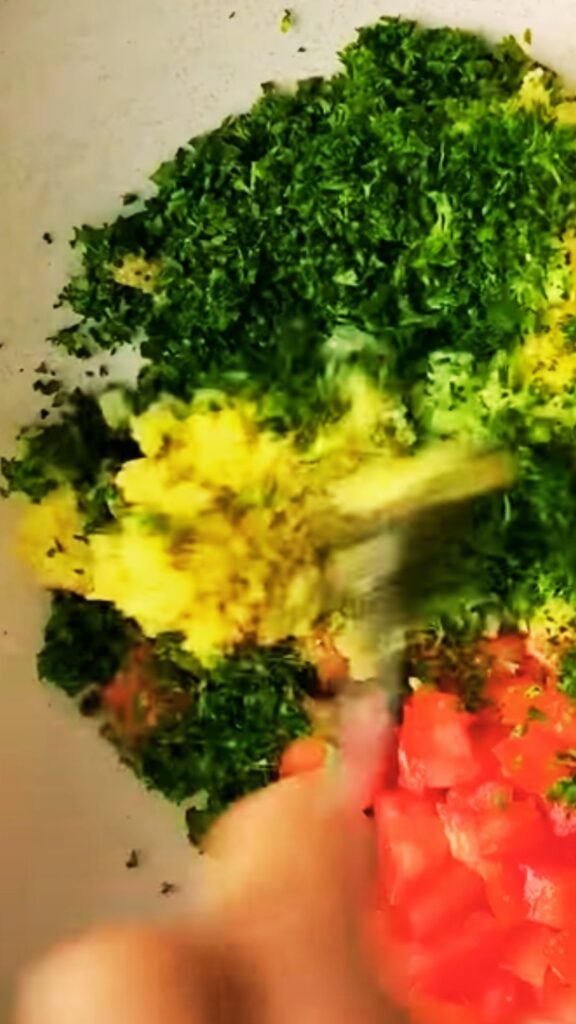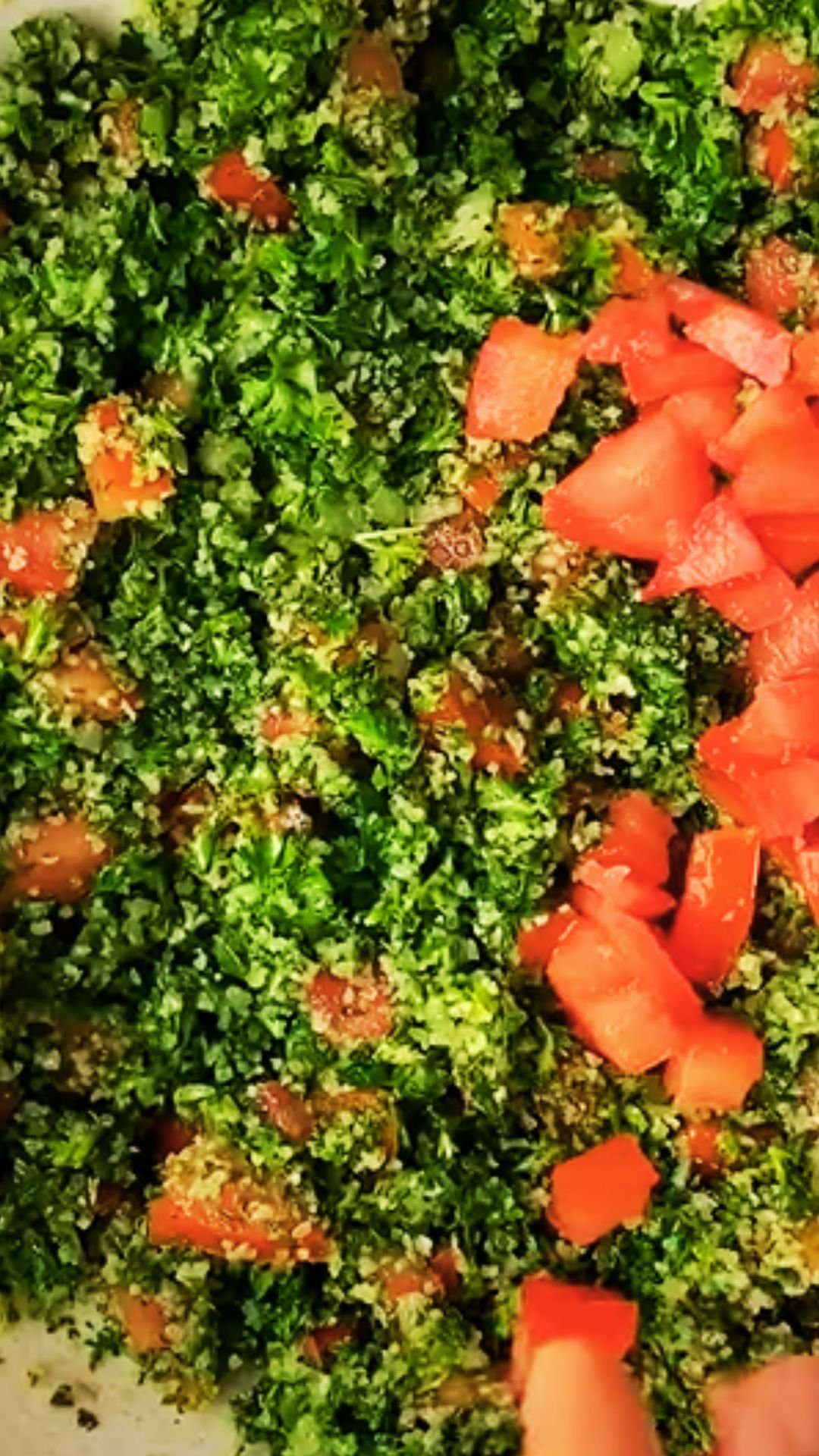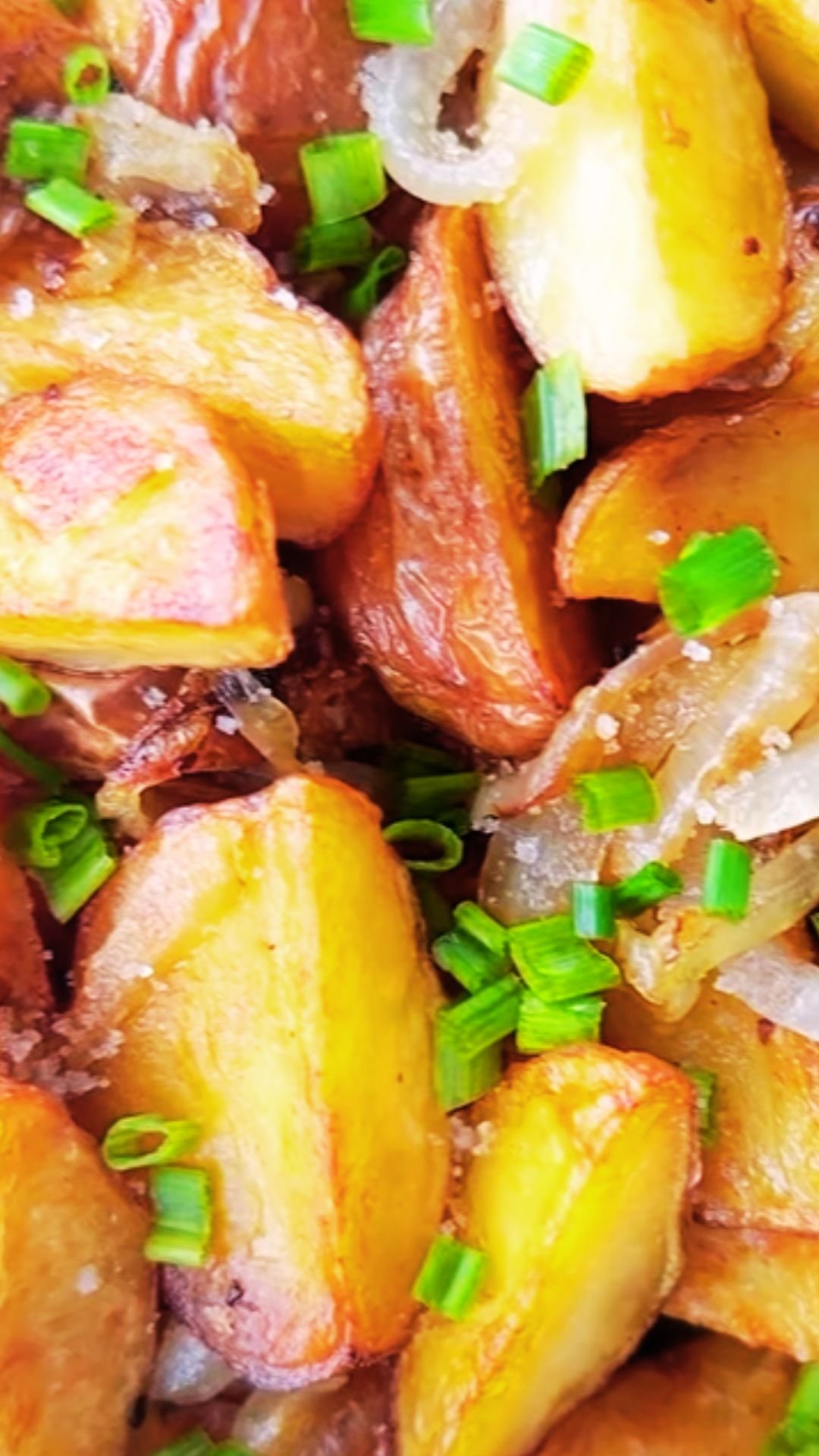When I first tasted authentic tabbouleh at a small Lebanese restaurant in Beirut, I knew immediately that everything I thought I knew about this beloved Middle Eastern salad was wrong. The vibrant green mixture before me bore little resemblance to the bulgur-heavy versions I’d encountered in Western restaurants. This wasn’t just a grain salad with herbs sprinkled on top – it was a celebration of fresh parsley, punctuated by tiny jewels of tomatoes and bulgur, all brought together with the bright acidity of lemon juice and the richness of olive oil.
Tabbouleh, or “tabboulah” as it’s known in Arabic, represents one of the purest expressions of Levantine cuisine. My journey to master this seemingly simple dish taught me that authenticity lies not just in ingredients, but in understanding the cultural significance and traditional techniques passed down through generations. Today, I’m sharing everything I’ve learned about creating genuine tabbouleh that honors its Middle Eastern roots while bringing sunshine to your kitchen table.
Understanding Authentic Tabbouleh
The key to authentic tabbouleh lies in recognizing what it truly is: a parsley salad, not a bulgur salad. Traditional Lebanese tabbouleh contains approximately 80% fresh herbs, primarily parsley, with bulgur serving as a subtle textural element rather than the main component. This fundamental understanding transformed my approach to the dish entirely.
Traditional Tabbouleh Components:
- Fresh flat-leaf parsley (the star ingredient)
- Fine bulgur wheat (minimal amount)
- Fresh tomatoes (finely diced)
- Fresh mint leaves
- Green onions or scallions
- Fresh lemon juice
- Extra virgin olive oil
- Salt and pepper
Regional Variations:
- Lebanese: Heavy on parsley, light on bulgur
- Syrian: Slightly more bulgur, similar herb ratio
- Palestinian: Often includes cucumber
- Turkish: May include additional vegetables
The beauty of authentic tabbouleh lies in its simplicity and the quality of its ingredients. Each component must be at its peak freshness to create the vibrant, refreshing salad that has graced Middle Eastern tables for centuries.
Selecting the Perfect Ingredients
My experience has taught me that ingredient selection can make or break your tabbouleh. Let me guide you through choosing each component with the discerning eye of a seasoned cook.
Parsley Selection Guide:
| Quality Indicator | What to Look For | What to Avoid |
|---|---|---|
| Leaf Color | Deep, vibrant green | Yellowing or brown edges |
| Texture | Crisp, firm leaves | Wilted or limp appearance |
| Aroma | Fresh, herbaceous scent | Musty or sour odors |
| Stems | Firm, not slimy | Soft, discolored stems |
| Overall Appearance | Perky, upright bunches | Drooping or compressed leaves |
Always choose flat-leaf (Italian) parsley over curly parsley. The flat variety has a more robust flavor and better texture for chopping. I prefer to buy parsley the day I plan to make tabbouleh, but if stored properly in the refrigerator wrapped in damp paper towels, quality parsley can maintain its freshness for up to a week.
Bulgur Wheat Wisdom:
Fine bulgur (#1 grade) is essential for authentic tabbouleh. Coarse bulgur will overpower the delicate herbs and create an unpleasant texture. I source my bulgur from Middle Eastern markets when possible, as they typically carry the finest grades. The bulgur should have a light, nutty aroma and uniform, small granules.
Tomato Considerations:
Roma or plum tomatoes work best due to their lower water content and firmer flesh. I avoid beefsteak tomatoes as they release too much juice, making the salad soggy. The tomatoes should be ripe but firm, with no soft spots or wrinkled skin.
The Art of Preparation

Preparing authentic tabbouleh is as much about technique as it is about ingredients. The way you handle each component affects both texture and flavor distribution throughout the salad.
Parsley Preparation Method:
- Remove thick stems, keeping only tender portions
- Wash thoroughly in cold water, swishing gently
- Spin dry completely in a salad spinner
- Spread on clean kitchen towels to air dry for 15 minutes
- Chop finely using a sharp knife, not a food processor
The chopping technique deserves special attention. I use a chef’s knife and employ a rocking motion, gathering the parsley periodically to ensure even chopping. The goal is pieces small enough that each forkful contains parsley without overwhelming any single bite.
Bulgur Preparation:
Unlike many grain salads, tabbouleh bulgur isn’t cooked in the traditional sense. Instead, it’s soaked and softened by the natural moisture from the vegetables and lemon juice.
- Rinse bulgur in fine-mesh strainer until water runs clear
- Drain thoroughly and squeeze out excess water
- Spread on clean kitchen towel for 10 minutes
- Transfer to mixing bowl and fluff with fork
Vegetable Preparation Timeline:
| Ingredient | Prep Time Before Serving | Special Notes |
|---|---|---|
| Parsley | 2-3 hours maximum | Chop just before mixing |
| Tomatoes | 30 minutes maximum | Salt lightly, drain excess juice |
| Mint | 1 hour maximum | Tear by hand, don’t chop |
| Green onions | 2 hours maximum | Use only white and light green parts |
The Complete Authentic Recipe
After years of perfecting my technique, here’s my authentic tabbouleh recipe that stays true to Lebanese traditions while accounting for ingredient availability in Western markets.
Ingredients (Serves 6-8):
Fresh Herbs:
- 3 large bunches fresh flat-leaf parsley, finely chopped (about 4 cups)
- 1/2 cup fresh mint leaves, torn into small pieces
- 6 green onions, white and light green parts only, finely chopped
Vegetables:
- 4 medium Roma tomatoes, seeds removed, finely diced
- 1/2 teaspoon salt (for tomatoes)
Grain:
- 1/4 cup fine bulgur wheat (#1 grade)
- 2 tablespoons warm water
Dressing:
- 1/3 cup fresh lemon juice (about 3 large lemons)
- 1/3 cup extra virgin olive oil
- 1 teaspoon salt, or to taste
- 1/2 teaspoon freshly ground black pepper
Detailed Preparation Steps:
- Prepare the bulgur: Rinse bulgur until water runs clear. Place in small bowl with warm water, stir, and let stand 10 minutes until slightly softened but still with bite.
- Prepare tomatoes: Dice tomatoes finely, removing seeds and excess juice. Toss with 1/2 teaspoon salt and let drain in colander for 15 minutes.
- Prepare herbs: Wash, dry, and finely chop parsley. Tear mint leaves by hand. Chop green onions finely.
- Make dressing: Whisk together lemon juice, olive oil, salt, and pepper until emulsified.
- Assemble: In large bowl, combine chopped parsley, mint, and green onions. Add drained bulgur and tomatoes. Pour dressing over mixture and toss gently but thoroughly.
- Rest and serve: Let tabbouleh rest at room temperature for 30 minutes before serving to allow flavors to meld.
Traditional Serving and Presentation
In Lebanese culture, tabbouleh is traditionally served on a platter surrounded by crisp romaine lettuce leaves, which serve as natural scoops. This method of serving connects diners to the dish in a tactile way that forks simply cannot replicate.
Authentic Serving Suggestions:
- Arrange on large, shallow platter
- Surround with inner romaine lettuce leaves
- Provide small spoons for those preferring utensils
- Serve at room temperature, never chilled
- Accompany with warm pita bread
- Include small bowls of extra lemon wedges
Meal Integration:
| Meal Type | Serving Role | Portion Size |
|---|---|---|
| Meze Spread | Featured salad | 1/2 cup per person |
| Main Course | Light lunch | 1 cup per person |
| Side Dish | Accompaniment | 1/3 cup per person |
| Appetizer | Starter | 1/4 cup per person |
Nutritional Benefits and Health Insights
Tabbouleh isn’t just delicious – it’s a nutritional powerhouse that exemplifies the health benefits of Mediterranean and Middle Eastern cuisines. My research into the dish’s nutritional profile has only deepened my appreciation for this ancient recipe.
Nutritional Profile per Serving:
| Nutrient | Amount | % Daily Value |
|---|---|---|
| Calories | 95 | 5% |
| Fiber | 3.2g | 13% |
| Vitamin C | 45mg | 75% |
| Vitamin K | 180mcg | 225% |
| Folate | 65mcg | 16% |
| Iron | 2.1mg | 12% |
Health Benefits Breakdown:
Antioxidant Powerhouse: The abundant fresh parsley provides exceptional levels of vitamins A, C, and K, plus flavonoids that support immune function and combat inflammation.
Digestive Support: The combination of fiber from bulgur and enzymes from fresh herbs aids digestion and promotes gut health.
Heart Health: Olive oil contributes healthy monounsaturated fats, while the potassium from tomatoes supports cardiovascular function.
Bone Health: The vitamin K content from parsley significantly exceeds daily requirements, supporting bone density and calcium absorption.
Storage and Make-Ahead Tips
One of the most common questions I receive about tabbouleh concerns storage and preparation timing. Unlike many salads, tabbouleh actually improves with a brief resting period, but there are important guidelines to follow.
Optimal Storage Guidelines:
Short-term (Same Day):
- Store at room temperature for up to 4 hours
- Cover loosely with clean kitchen towel
- Toss gently before serving
Refrigerated Storage:
- Maximum 24 hours for best quality
- Store in airtight container
- Bring to room temperature before serving
- May need additional lemon juice after storage
Make-Ahead Strategy:
I’ve developed a system that allows me to prepare components in advance while maintaining optimal freshness:
- Day Before: Wash and thoroughly dry parsley, store wrapped in paper towels
- Morning Of: Chop parsley, prepare bulgur, make dressing separately
- 2 Hours Before: Dice tomatoes, combine all ingredients except dressing
- 30 Minutes Before: Add dressing and final seasoning adjustments
Troubleshooting Common Issues
Through teaching countless friends and family members to make tabbouleh, I’ve encountered every possible mistake and learned how to prevent or correct them.
Common Problems and Solutions:
| Problem | Cause | Solution |
|---|---|---|
| Soggy texture | Too much tomato juice | Salt tomatoes, drain thoroughly |
| Overpowering bulgur | Wrong grade or too much | Use fine bulgur, reduce quantity |
| Wilted herbs | Added dressing too early | Dress just before serving |
| Bland flavor | Insufficient acid or salt | Adjust lemon juice and salt |
| Tough parsley | Dull knife, poor technique | Sharp knife, proper chopping method |
Seasoning Adjustments:
The final seasoning of tabbouleh requires a delicate balance. I always taste and adjust in this order:
- Salt (enhances all other flavors)
- Lemon juice (provides brightness)
- Black pepper (adds depth)
- Olive oil (rounds out the flavors)
Cultural Significance and Variations
Understanding tabbouleh’s cultural importance has enriched my appreciation for this humble yet sophisticated dish. In Lebanese culture, the quality of a cook’s tabbouleh often serves as a measure of their culinary skill and attention to detail.
Regional Variations I’ve Encountered:
Lebanese Style: The gold standard, emphasizing parsley with minimal bulgur Syrian Version: Slightly more bulgur, sometimes includes chopped cucumber Palestinian Adaptation: Often features diced cucumber and sometimes radishes Modern Interpretations: May include quinoa instead of bulgur, though purists disapprove
Each variation reflects local tastes and ingredient availability, but the core principle remains: fresh herbs should dominate, with other ingredients providing supporting flavors and textures.
Questions and Answers
Q: Can I substitute curly parsley for flat-leaf parsley in tabbouleh? While possible, I strongly recommend against it. Curly parsley has a more bitter flavor and tougher texture that doesn’t break down as nicely when chopped. Flat-leaf parsley’s tender leaves and superior flavor are essential for authentic results.
Q: How far in advance can I make tabbouleh? I never recommend making tabbouleh more than 24 hours in advance. The herbs begin to lose their vibrant color and fresh flavor, while the vegetables release moisture that can make the salad soggy. For best results, prepare it the same day you plan to serve it.
Q: Why does my tabbouleh taste bland compared to restaurant versions? The most common issue is insufficient seasoning, particularly salt and lemon juice. Restaurant tabbouleh often has more aggressive seasoning than home cooks typically use. Also, ensure you’re using enough fresh herbs – they should comprise at least 75% of the salad.
Q: Can I make tabbouleh without bulgur for a gluten-free version? Yes, though it changes the traditional character of the dish. You can substitute finely chopped cauliflower, quinoa, or simply omit the grain entirely. The salad will still be delicious, just different from the traditional version.
Q: What’s the best way to chop parsley for tabbouleh? Use a sharp chef’s knife and employ a rocking motion, keeping the tip on the cutting board. Avoid food processors, which can bruise the herbs and create an uneven texture. Gather the parsley periodically while chopping to ensure uniformity.
Q: Should tabbouleh be served cold or at room temperature? Traditional tabbouleh is served at room temperature. Serving it cold mutes the flavors and makes the olive oil congeal slightly. If you’ve stored it in the refrigerator, let it come to room temperature for 30 minutes before serving.
Q: How do I prevent my tabbouleh from becoming watery? The key is properly preparing the tomatoes by salting them and allowing excess moisture to drain. Also, ensure your parsley is completely dry after washing, and don’t overdress the salad. Add dressing gradually until you achieve the right consistency.
Q: Can I add other vegetables to traditional tabbouleh? While purists prefer the classic combination, some regional variations include cucumber or radishes. However, additions like bell peppers or carrots move away from authenticity. If you want to experiment, do so sparingly and consider the flavor balance.
Making authentic tabbouleh has become one of my greatest culinary pleasures – not just for the bright, fresh flavors it brings to my table, but for the connection it provides to centuries of Middle Eastern culinary tradition. Every time I prepare this salad, I’m reminded that the best dishes often appear simple on the surface while requiring genuine skill and understanding to execute properly.
The beauty of tabbouleh lies in its honest celebration of fresh ingredients at their peak. When you master the balance of herbs, acid, and oil, you’re not just making a salad – you’re creating a dish that embodies the essence of healthy, flavorful eating that has sustained Mediterranean cultures for generations.
I encourage you to approach tabbouleh with patience and respect for its traditions. Start with the finest ingredients you can find, pay attention to technique, and don’t be afraid to adjust seasoning to your taste. Once you experience authentic tabbouleh made with care and understanding, you’ll never settle for the bulgur-heavy imitations that have unfortunately become common in many Western interpretations.
The next time you prepare this remarkable salad, remember that you’re participating in a culinary tradition that spans cultures and generations. Let the vibrant green of fresh parsley and the bright acidity of lemon transport you to sun-soaked Mediterranean terraces where this dish first graced family tables centuries ago.


